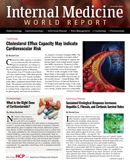Publication
Article
Warfarin for Atrial Fibrillation?
Author(s):
A recent study published in the Journal of the American Medical Association looked at whether the prescription, which also required the patient continuously monitor their coagulation, was the best option. The study focused on whether mechanical left atrial appendage would be preferable for patients going forward.

For patients diagnosed with atrial fibrillation, one of the more popular treatment courses is warfarin.
Journal of the American Medical Association
A recent study published in the looked at whether the prescription, which also required the patient continuously monitor their coagulation, was the best option. The study focused on whether mechanical left atrial appendage would be preferable for patients going forward.
The study was multicenter, randomized, and un-blinded involving 707 patients at 59 hospitals who had nonvalvular atrial fibrillation and “at least one additional stroke risk factor.” Participants first enrolled in the study in February 2005 and were observed for a 4-year period until October 2012. In total, 463 patients received the device while 244 were treated with warfarin.
Study authors noted that at an average follow-up of 3.8 (1.7) years, there were a total of 39 out of 463 events of the patients. That made for 8.4% in the device group which they estimated as 2.3 events for every 100 patient years. The warfarin group saw 34 events in 244 patients. That made for 13.9% of the participants in that group having a primary event or 3.8 events for every 100 years (rate ratio, 0.50; 95% credible interval, 0.41-1.05).
The most frequent stroke risk reported was hypertension and the authors noted that just under one fifth of the patient pool had suffered a stroke or TIA. Nearly two-fifths had paroxysmal atrial fibrillation and most had been diagnosed at least one-year prior to the start of the trial. Close to half the patients involved had also been taking warfarin for at least one year prior to the trial.
The study results met the criteria set by the authors for non-inferiority (posterior probability, >99.9%) and superiority (posterior probability, 96.0%). In the device group, the authors noted lower rates for cardiovascular mortality (1.0 events per 100 patient-years.
The data also showed just 17 out of 463 patients, or 3.7% of the device group reported cardiovascular mortality compared to 22 out of 244, or 9% in the warfarin group. The results were also similar for all-cause mortality with reports of 3.2 events per 100 patient years in the device group compared to 4.8 events per 100 patient years for warfarin.
According to the authors, the most frequent adverse events were “serious pericardial effusions and major bleeding in the device and warfarin groups, respectively.” They added, “Unlike the linear evolution of events over time during warfarin therapy, a bimodal distribution was observed after device implantation with the predominating adverse events-pericardial effusion, procedure-related stroke, and device embolization -- occurring in the periprocedural period.”
The final results suggested the all-cause mortality rate in the warfarin group was 21.5%, which was considerably worse than the 14.5% in the device group.
“After 3.8 years of follow-up in patients with nonvalvular AF at elevated risk for stroke, percutaneous LAA closure met criteria for both noninferiority and superiority, compared with warfarin therapy, for preventing the combined outcome of stroke, systemic embolism, and cardiovascular death, as well as superiority for cardiovascular mortality and all-cause mortality,” the authors concluded.






